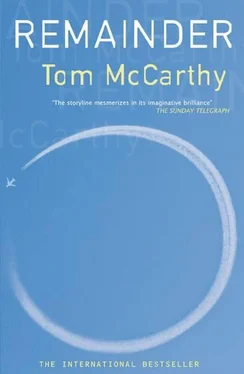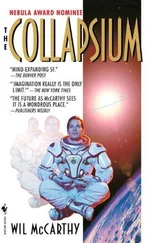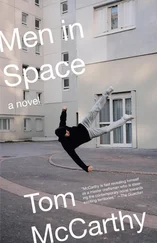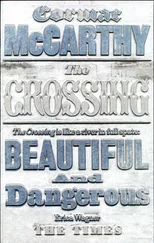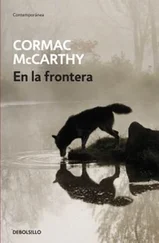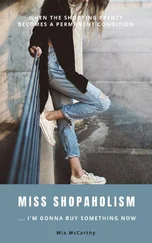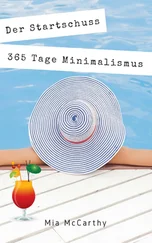“So,” he said. “This is the man who is re-staging the deaths of local gangsters who have met with violent ends.”
I could place him now: he’d been at the re-enactment of the first shooting-the man I’d seen standing behind the waiting BMW when I’d first arrived. He looked semi-official: smartish but a little ragged round the edges. Off-smart. He had a graphite-coloured jacket on and grey streaks in his hair. He must have been forty-odd.
“Are you a policeman?” I asked him.
“No,” he said. He glanced at his notebook again, then continued: “This is also the man who has had set up a building in which certain mundane and, on the surface, meaningless moments are repeated and prolonged until they assume an almost sacred aspect.”
His voice had a slightly Scottish edge. It was quite dry. He spoke in the kind of tone a lawyer might use to address a jury, or a serious professor of history his students. I lay there, listening to him.
“He has, moreover, had the most trivial of incidents-a spillage that occurred during a visit to a tyre repair shop-played and replayed like a stuck record for the last three weeks, residual.”
“I’d forgotten about that,” I said.
“Forgotten about that, he says?” His tone rose slightly as he uttered this rhetorical question, then dipped again as he ploughed on. “No less than one hundred and twenty actors have been used. Five hundred and eleven props-tyres, signs, tins, tools, all in working condition-have been assembled and deployed. And that’s just for the tyre shop scene. The number of people who have been employed in some capacity or other over the course of all five re-enactments must be closer to one thousand.” He paused again and let the figure sink in, then continued: “All these actions, into which so much energy has been invested, so many man-hours, so much money-all, taken as a whole, confront us with the question: for what purpose?”
He paused and looked at me intently.
“Does he, perhaps,” he started again suddenly, “consider himself to be some kind of artist?”
He was still looking intently at me, as though calling on me to give an answer.
“Who, me?” I said.
His eyes mockingly scoured the empty room, then came to rest on me again.
“No,” I told him. “I was never any good at art. In school.”
“In school, he wasn’t any good at art,” he repeated, then struck off on another tack: “In that case, could it rather be that he sees these acts as a kind of voodoo? Magic? As shamanic performances?”
“What’s shamanic?” I asked.
Naz walked in just then. He seemed to know this man: he nodded at him, then started tapping at his mobile.
“Who is this?” I asked him.
“A borough councillor,” Naz said. “He kept us posted on the shooting and found us our police mole. Don’t worry: he’s sound.”
I wasn’t worried. I felt quite at ease just lying there, passive, being talked about. The piano music spilled up from downstairs.
“He’s listening to Shostakovich,” the short councillor said.
“It’s Rachmaninov,” Naz told him.
“Ah, Rachmaninov. And there’s a smell, a kind of…is it cordite?”
“Yes!” I tried to shout to him, but my voice came out weak. “Yes: finally! It is cordite! I knew it!”
Naz’s phone beeped. He read from its screen:
“Of or pertaining to a priest-doctor of the Ural-Altaic peoples of Siberia. From the Tungusian saman.”
“Cordite! Didn’t I say, right from the beginning…” I began, but then slipped off into a trance again.
I saw this councillor again, the next afternoon, or perhaps the one after that. I was feeling a lot stronger and had ventured out of my building to take some air beside the sports track. I was leaning by the knitted green wire fence watching a football team train. They were practising shooting: their coach placed ball after ball on the green asphalt surface among all the intersecting lines and circles and they ran up, one after the other, and kicked the balls into the goal, or tried to. Some of the balls missed, ricocheted back off the fence and got in the next shooter’s way. The coach was shouting at his players to encourage them:
“Project!” he told them. “Will it in the goal. Take your time. Slow each second down.”
This was good advice. You could see the ones who got the balls in breaking their movements into segments, really concentrating on each one. It wasn’t that they took more time than the ones who missed-rather that they made the same amount of time expand. That’s what all good sportsmen do: fill time up with space. That’s what sprinters are doing when they run a hundred metres in less than ten seconds: they’re expanding every second, every half-second, as though the moment were a cylinder around them and they were pushing its edges outwards so it takes in more track, more for them to run down before they reach the second’s edge. A boxer who can duck, feint, twist and lunge before his opponent even sees him move, or a batsman who can calmly read, decode and play the swing and bounce of the hurtling ball: they’re filling time up with space too. So are men who can catch bullets: it’s easy enough if you just give yourself enough room to manoeuvre in. Watching these football players shoot now, I felt a huge wave of sadness for the three men who’d been killed, and an even greater one at not having managed, in my re-enactments, to fill the instant of their death with so much space that it retrieved them, kinked them back to life. Impossible, I know, but I still felt responsible, and sad.
The coach had introduced a new rule: if a player missed, he had to run around the track that hemmed the football pitch in. Three or four of them were jogging round it sluggishly, beneath the broken loudspeakers.
“In his coma,” a voice beside me said, “he had to give a commentary.”
It was the short councillor again. He was standing by the fence beside me with his fingers poking through the diamond-shaped green holes. He must have been standing there for some time without me noticing him.
“Yes,” I said. “It’s true.” I didn’t remember telling him that bit, about the sports dreams in my coma as I lay unconscious in the weeks after the accident. “There was a format,” I said, “and I had to fill it, or I’d die.”
“And ever since that time he’s felt unreal. Inauthentic.”
“Yes,” I replied. I didn’t remember telling him that bit either, but I must have done and then forgotten that I’d told him as I slipped into my trance.
“So when, recently, has he felt most real?” the short councillor asked. “When has he felt least inauthentic?”
It was a very good question. I’d been so busy, so driven over the last few months, moving from project to project, from the building re-enactments to the tyre shop ones and then on to the shootings, that I hadn’t paused to take stock of them all, to compare and contrast them, to ponder the question: Which one has worked best? They’d all had the same goal, their only goal: to allow me to be fluent, natural, to merge with actions and with objects until there was nothing separating us-and nothing separating me from the experience that I was having: no understanding, no learning first and emulating second-hand, no self-reflection, nothing: no detour. I’d gone to these extraordinary lengths in order to be real. And yet I’d never stopped and asked myself if it had worked. Naz had kind of asked me after the first building re-enactment-and the question had struck me as odd. The realness I was after wasn’t something you could just “do” once and then have “got”: it was a state, a mode-one that I needed to return to again and again and again. Opioids, Trevellian had said: endogenous opioids. A drug addict doesn’t stop to ask himself: Did it work? He just wants more-bigger doses, more often: more.
Читать дальше
